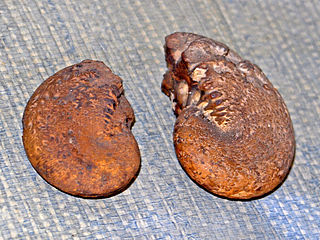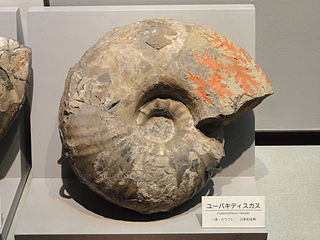
Euhoplites is an extinct ammonoid cephalopod from the Lower Cretaceous, characterized by strongly ribbed, more or less evolute, compressed to inflated shells with flat or concave ribs, typically with a deep narrow groove running down the middle. In some, ribs seem to zigzag between umbilical tubercles and parallel ventrolateral clavi. In others the ribs are flexuous and curve forward from the umbilical shoulder and lap onto either side of the venter.

Parahoplitidae is an extinct family of Cretaceous ammonites with stoutly ribbed, compressed, generally involute shells lacking or with only minor tubercles included in the Deshayestoidea, a superfamily now separated from the Hoplitacaceae.
Ancyloceratoidea, formerly Ancylocerataceae, is a superfamily of typically uncoiled and loosely coiled heteromorph ammonoids established by Alpheus Hyatt in 1900, that may contain as many as 11 families, depending on the classification accepted.

Phylloceratidae is the predominant family of the Phylloceratina with some 15 or more genera found in rocks ranging from the Lower Jurassic to the Upper Cretaceous. Members of the Phylloceratidae are characterized by smooth, involute shells with very thin walls. Many are covered with fine growth lines but are usually without ribbing. Sutures are complex with the major and minor branches of the saddles with phylloid or spatulate endings.

Eupachydisus is a large, coarse-ribbed Pachydiscid ammonite genus from the Upper Cretaceous, found in Coniacian to Campanian age strata in Europe, Madagascar, Japan, and British Columbia.

Collignoniceratidae is a family of Upper Cretaceous ammonites characterized by typically more or less evolute shells with compressed, oval, or square whorl sections; serrate or entire keels; and dense ribs with one to 5 tubercles.

Lytoceratidae is a taxonomic family of ammonoid cephalopods belonging to the suborder Lytoceratina, characterized by very evolute shells that generally enlarge rapidly, having whorls in contact but mostly overlapping very sightly, or not at all.
Brancoceratidae is a family of acanthoceratoid ammonites from the middle of the Cretaceous, recognized by their commonly evolute shells with round, oval, or quadrate whorls, strong ribs, usual ventral keels, and at least, umblical tubercles. The family is thought to be derived from the Desmoceratidae (Desmoceratoidea), perhaps from Silesitoides or some allied genus.

Ancyloceratidae is a family of heteromorphic ammonites that lived during the Early Cretaceous. Their shells begin as a loose spiral with whorls not touching which then turns into a straight shaft that ends in a J-shape hook or bend at end. Coarse ribbing and spines are common.

Calliphylloceras is an ammonite belonging to the Phylloceratidae.

Lewesiceras is a genus of large ammonites belonging to the order Ammonitida and the family Pachydiscidae.

Mantelliceras is an extinct ammonoid cephalopod genus belonging to the family Acanthoceratidae and type for the subfamily Mantelliceratinae, that lived from the Late Albian to the late Cenomanian stage of the Late Cretaceous.

Neocomitidae is a family of Lower Cretaceous ammonitids comprising genera with strongly ribbed evolute to smooth, fairly involute shells.

Hemihoplitidae is an extinct family of ammonoid cephalopods belonging to the superfamily Ancyloceratoidea. Fossils of species within this genus have been found in the Cretaceous rocks of southeastern France, Mexico, Slovakia, South Africa and Trinidad and Tobago.

Kossmaticeratidae is an extinct ammonoid family belonging to the order Ammonitida.

The Acanthoceratinae comprise a subfamily of ammonoid cephalopods that lived during the Late Cretaceous from the latter early Cenomanian to the late Turonian
Neocardioceras is a genus of evolute acanthoceratid ammonites from the uppermost Cenomanian, Upper Cretaceous, of Europe, western U.S. and Brazil.
Romaniceras is a genus of Upper Cretaceous ammonites in the Acanthoceratidae subfamily Euomphaloceratinae.

Lyelliceratidae is a family of ammonites belonging to the superfamily Acanthoceratoidea.

Diplomoceratidae is a family of ammonites included in the order Ammonitida. Fossils of species within this genus have been found in the Cretaceous sediments. Studies of Diplomoceras suggest that members of this family could reach lifespans of over 200 years.
















